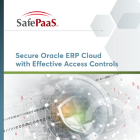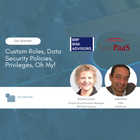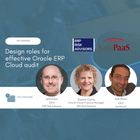Top 5 Threats in Oracle ERP Cloud


Top 5 Threats in Oracle ERP Cloud
and How to Eliminate Them
Insight from ERP Risk Advisors and SafePaaS
Business processes are data-driven and interconnected. Enterprise Resource Planning (ERP) systems, like Oracle ERP Cloud, are essential in streamlining processes, centralizing data, and enhancing efficiency and productivity.
However, with great power comes great responsibility, and protecting your ERP and sensitive data is critical for ensuring the integrity of your operations. As your organization grows and relies increasingly on ERP solutions, you need to stay focused on detecting and mitigating threats that could compromise your security.
Understanding the Threat Landscape
In this guide, we'll discuss the top five Oracle ERP Cloud security threats and provide insights on detecting and mitigating them. From access risk to insider threats and ineffective user provisioning, we'll explore the challenges that ERP systems experience and offer actionable tips to strengthen your Oracle ERP Cloud security defenses.
Access Risk (Threat #1)
Access Risk refers to the potential of unauthorized individuals gaining access to sensitive data or systems in your organization. This can happen due to insufficient access controls, weak authentication mechanisms, or improper handling of user permissions.
Access risk management involves implementing strong access control measures such as policy-based access control (PBAC), least privilege access, and regular periodic access reviews to mitigate the risk of unauthorized access.
Example: Unauthorized Access to Financial Data
Unauthorized access to sensitive financial data in Oracle ERP Cloud could result in fraudulent transactions, while unauthorized access to employees' personal information stored in the HR module could lead to privacy breaches and compliance violations.
Mitigation Strategies
- Implement policy-based access control (PBAC)
- Enforce least-privilege access
- Conduct regular periodic access reviews
Insider Threats (Threat #2)
Insider threats refer to individuals who misuse their authorized access or privileges to harm the organization's security, data integrity, or reputation, whether intentionally or unintentionally.
Insider threats can arise from employees, contractors, or partners who misuse their access rights, resulting in theft of sensitive information, fraud, or system sabotage. Organizations should implement monitoring controls to detect and mitigate insider threats and enforce strict access controls and auditing policies.
Example: Misuse of Privileges
For example, users with access to procurement functions in Oracle ERP Cloud may use their privileges to create fake purchase orders for personal gain, or a disgruntled employee may sabotage system configurations, resulting in operational disruptions.
Mitigation Strategies
- Implement monitoring controls
- Enforce strict access controls and auditing policies
Seeded Roles (Threat #3)
Seeded roles are preset or templates with the Oracle ERP Cloud system. They contain a set of access privileges that are commonly required for specific job functions or responsibilities.
Although these roles can be helpful in user provisioning, they may not always match an organization's unique security requirements. Therefore, organizations must customize these seeded roles to better fit their specific needs and security policies. These role customizations ensure that users are granted appropriate access permissions without unnecessary privileges.
Example: Default "Financial Analyst" Role
For instance, Oracle ERP Cloud's default "Financial Analyst" role may give excessive access to sensitive financial data and reports, leading to data leakage or unauthorized modifications if not customized to match the organization's security policies.
Mitigation Strategies
- Customize seeded roles to match organizational security policies
- Conduct regular reviews of pre-defined roles and their mappings
Ineffective User Provisioning (Threat #4)
Ineffective user provisioning occurs when users are granted either inadequate or excessive access to their roles and responsibilities. This can lead to security risks, compliance violations, and operational inefficiencies.
Your organization should establish standardized user provisioning processes, implement automated provisioning solutions, and conduct regular access reviews to address this.
Example: Default Administrator Privileges
For example, a new employee is granted administrator privileges in Oracle ERP Cloud by default instead of role-based access tailored to their job responsibilities, increasing exposure to security threats and compliance risks.
Mitigation Strategies
- Establish standardized user provisioning processes
- Implement automated provisioning solutions
- Conduct regular access reviews
Configuration Changes (Threat #5)
Configuration Changes refer to modifications made to your Oracle ERP Cloud system's settings, parameters, or configurations. These modifications may include changes to APIs, web services, or database configurations.
Any changes to the system's settings can significantly impact its security, performance, and functionality. If the system's settings are improperly configured or changed, the vulnerability, security weakness, or compatibility issues can lead to security breaches or system failures.
Therefore, organizations must implement change control processes, conduct thorough testing, adhere to best practices for secure configuration management, and closely monitor and manage configuration changes to mitigate the risk of configuration-related issues.
Example: Improper Configuration of Authentication Settings
Improper configuration of user authentication settings may lead to unauthorized access or misconfiguration of integration interfaces, exposing sensitive data to external threats during data exchanges with third-party systems.
Mitigation Strategies
- Implement change control processes
- Conduct thorough testing
- Adhere to best practices for secure configuration management
Access governance solutions provide a strong framework for ensuring Oracle ERP Cloud remains secure, compliant, and optimized for performance. Your organization can reduce Oracle ERP Cloud risks by implementing access governance measures and ensuring security, integrity, and compliance.
Now that you're equipped with a deeper understanding of the top threats facing Oracle ERP Cloud and actionable strategies to mitigate them, it's time to take steps to safeguard your organization's digital assets.
Here's what you can do next:
Start implementing some or all of these strategies now to ensure your organization stays resilient in the face of evolving ERP threats.
Contact ERP Risk Advisors and SafePaaS for more information.
Recommended Resources

Secure Oracle ERP Cloud with Effective Access Controls
When considering a move to Oracle ERP Cloud, it’s key for organizations to design a robust security model as part of the implementation project - not leave it until after deployment.

Custom Roles, Data Security Privileges...
You've decided to customize security roles to provide specific access to your users, but there is the security console, job roles, duty roles, privileges, data security policies, aggregate privileges. With so much to know and understand, where do you start?

Role Design in Oracle ERP Cloud
You´ve made the decision to move to Oracle ERP Cloud, however, what you don’t realize is the huge effort and know-how needed to not only design but deploy well-designed, effective roles. There is a misconception that seeded roles have been designed with security and compliance considered. Unfortunately, this is not the case.

